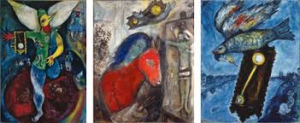 Closing February 2, the Chagall: Love, War, and Exile, exhibit at the Jewish Museum in Manhattan should not be missed. This exhibit of paintings, prints and artifacts makes its debut in the United States, showing an important period in Marc Chagall’s artistic career: the effect of the fascism and World War II on his creativity. It also show the impact of the death of his wife Bella in 1944 and the inclusion of his new wife Virginia Haggard McNeil into his paintings, which are filled with many familiar icons of earlier works.
Closing February 2, the Chagall: Love, War, and Exile, exhibit at the Jewish Museum in Manhattan should not be missed. This exhibit of paintings, prints and artifacts makes its debut in the United States, showing an important period in Marc Chagall’s artistic career: the effect of the fascism and World War II on his creativity. It also show the impact of the death of his wife Bella in 1944 and the inclusion of his new wife Virginia Haggard McNeil into his paintings, which are filled with many familiar icons of earlier works.
Always hearkening back to Vitebsk, the village in Belarus/Russia of Chagall’s birth, the paintings include fondly remembered symbols of the shtetl or village, such as the cow, a brightly colored horse, houses, violinists, religious villagers and mothers with children. Later, darker paintings incorporate Chagall’s memories of the Bolshevik Revolution, a dark period of exile from his beloved Russia to France. The exhibition includes 31 paintings and 22 works on paper, as well as telegrams, letters, poems, photos, books and more, all works of Marc Chagall or ephemera from his life.
Chagall: Love, War and Exile focuses on the artist’s works from the 1930s through 1948, following his move to Paris in 1922 (where he changed his name from Moishe Shagal/Segal to the more French Marc Chagall and incorporated much French style into his paintings), and during his second exile to New York at the invitation of Alfred Barr of the Museum of Modern Art. One of the most revered modernist painters, Marc Chagall (1887–1985) displays here the influences on his style from folk art, religious painting, Cubism and even Surrealism (one painting shows a “walking” street lamp). Especially interesting is his attempt at outreach to both Christians and Jews, showing frequent depictions of the Crucifixion of Jesus as well as of Jesus in the form of Jewish figures wearing Jewish religious vestments, both functioning as an everyman symbol of anyone who has been the victim of persecution.
Moving from the folk style of Russian art, to French-influenced flower-filled paintings, darker persecution-themed paintings, and mourning images following his wife’s death, Chagall finally shows splashes of color again in the final paintings of the exhibit. World War II has ended, Chagall has re-married and has a second child. Themes of his past — “the village” that he so adored — remain but are now more vibrant, showing the Chagall that one has come to know more familiarly from his earlier paintings like “I and the Village” (1911) at the Museum of Modern Art.
The Jewish Museum, 1109 Fifth Avenue, 1109 5th Ave, Manhattan, (212) 423-3200 http://www.thejewishmuseum.org

